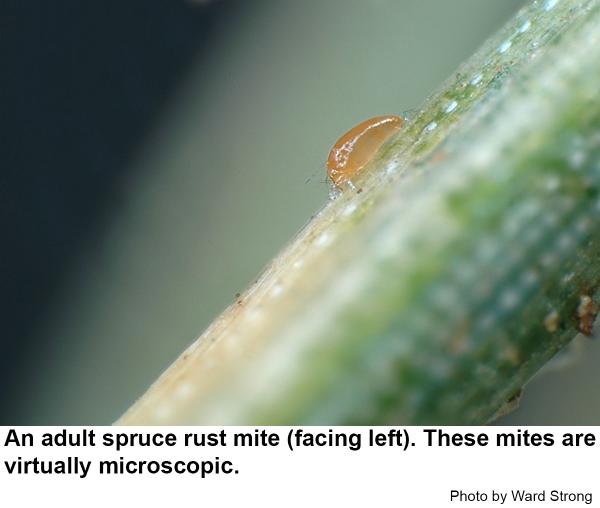Description and Biology
The spruce rust mite, Nalepella halourga, is restricted to spruce, so this virtually microscopic mite will not spread to plants other than spruce. These mites are pale and colorless to pale yellow during the growing season. In the fall, these mites are reddish-purple. The body is shaped like a fat carrot, and it has four legs and the mouth parts at the front. Females lay relatively large eggs that develop through two nymph stages before molting into adults. They overwinter as eggs on spruce needles. Eggs hatch in very early spring, as early as mid-March, and several generations occur each year. These are cool season mites that do most of their damage during spring (especially cool, dry springs) and fall. Populations are usually very low in the hot summer months and during the coldest parts of winter. Overwintering eggs are red and very, very tiny found in clusters on the undersides of needles. Most of the eggs are laid on the needles of the underside of the branch. Sometimes the eggs are densely packed to the point that the area of the needle appears rusty.
Host Plants
Spruce rust mites only infest spruce including black spruce and Norway spruce. Affected shoots appear russeted or bronze in color. These mites tend to infest the upper portion of spruces. Although it is considered a “moderate” pest of spruce, when spruce rust mites are abundant, the whole plant may turn grayish or yellowish.
Residential Recommendations
Because spruce rust mites are so small, their tiny mouthparts can only pierce the epidermis of the needle. A tiny pale spot forms at each feeding puncture as the mites inject their saliva and suck out the predigested cell contents. Spruce rust mites are sensitive to Sevin insecticide. This is the only pesticide I know of that is actually labeled for eriophyid mites (the family of mites that the spruce rust mite is in). A horticultural oil or insecticidal soap should give adequate control as well. Oil may dissolve the waxy coating that give spruces their attractive appearance so Sevin may be the best choice.
References
- An Illustrated Guide to Plant Abnormalities Caused by Eriophyid Mites in North America. Keifer, H. H., et al. 1982. USDA ARS Agr. Handbook No. 573. 178 pages.
- Eriophyid Rust and Sheath Mites. Rajotte, E. No Date. Penn State Extension.
- Notes on the Genus Nalepella (Acarina: Eriophyoidea) and the Occurrence of N. halourga on Black Spruce in Canada. Marshall, V. G. and E. E. Lindquist. 1972. The Canadian Entomologist 104 (02): 239-244.
- Extension Plant Pathology Publications and Factsheets
- Horticultural Science Publications
- North Carolina Agricultural Chemicals Manual
For assistance with a specific problem, contact your local N.C. Cooperative Extension Center.
This Factsheet has not been peer reviewed.
Publication date: May 2, 2016
Reviewed/Revised: Oct. 15, 2019
Recommendations for the use of agricultural chemicals are included in this publication as a convenience to the reader. The use of brand names and any mention or listing of commercial products or services in this publication does not imply endorsement by NC State University or N.C. A&T State University nor discrimination against similar products or services not mentioned. Individuals who use agricultural chemicals are responsible for ensuring that the intended use complies with current regulations and conforms to the product label. Be sure to obtain current information about usage regulations and examine a current product label before applying any chemical. For assistance, contact your local N.C. Cooperative Extension county center.
N.C. Cooperative Extension prohibits discrimination and harassment regardless of age, color, disability, family and marital status, gender identity, national origin, political beliefs, race, religion, sex (including pregnancy), sexual orientation and veteran status.


